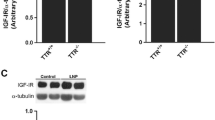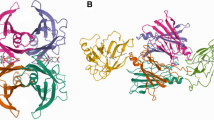Abstract
Oestrogen protects against AD by multiple mechanisms, including the enhancement of Aβ clearance. Transthyretin (TTR) is a homotetrameric protein mainly synthesized by the liver and choroid plexus (CP) of the brain that sequesters the amyloid beta (Aβ) peptide. In this study we examined the effects of 17β-estradiol (E2) on TTR protein and mRNA levels, in primary cultures of rat CP epithelial cells (CPEC) by Western blot and Real Time PCR, respectively. Moreover, the localization of oestrogen receptors alpha (ERα) and beta (ERβ) in response to E2 treatment was analysed by confocal microscopy in these cells. The expression of TTR, ERα and ERβ was also compared in the CP of castrated female mice treated with E2 to vehicle-treated animals by Real Time PCR. TTR concentration in the CSF of all these animals was measured by radioimmunoassay. E2 treatment induced TTR transcription and increased TTR protein content in CPEC. Pre-treatment with ICI 182,780 (ICI) abrogated E2-induced TTR expression suggesting that, TTR is up-regulated via an ER-dependent pathway. Confocal microscopy demonstrated extranuclear ERα and ERβ localization in untreated CPEC. Upon E2 treatment, translocation of ERα to the nucleus occurred, while ERβ remained in the cytosol. These data was concurrent with the up-regulation of TTR expression detected in the CP of castrated female mice subjected to E2 treatment. Our results highlight the importance of E2 on the regulation of TTR, which may participate in the oestrogen-induced decrease in Aβ levels and deposition described in the literature.





Similar content being viewed by others
References
Aldred AR, Brack CM, Schreiber G (1995) The cerebral expression of plasma protein genes in different species. Comp Biochem Physiol 111:1–15
Carroll JC, Pike CJ (2008) Selective estrogen receptor modulators differentially regulate Alzheimer-like changes in female 3xTg-AD mice. Endocrinology 149:2607–2611. doi:10.1210/en.2007-1346
Chen S, Nilsen J, Brinton RD (2006) Dose and temporal pattern of estrogen exposure determines neuroprotective outcome in hippocampal neurons: therapeutic implications. Endocrinology 147:5303–5313. doi:10.1210/en.2006-0495
Choi SH, Leight SN, Lee VM, Li T, Wong PC, Johnson JA, Saraiva MJ, Sisodia SS (2007) Accelerated Abeta deposition in APPswe/PS1deltaE9 mice with hemizygous deletions of TTR (transthyretin). J Neurosci 27:7006–7010. doi:10.1523/JNEUROSCI.1919-07.2007
Costa R, Goncalves A, Saraiva MJ, Cardoso I (2008) Transthyretin binding to A-Beta peptide–impact on A-Beta fibrillogenesis and toxicity. FEBS Lett 582:936–942
Eckman EA, Adams SK, Troendle FJ, Stodola BA, Kahn MA, Fauq AH, Xiao HD, Bernstein KE, Eckman CB (2006) Regulation of steady-state beta-amyloid levels in the brain by neprilysin and endothelin-converting enzyme but not angiotensin-converting enzyme. J Biol Chem 281:30471–30478. doi:10.1074/jbc.M605827200
Gloeckner SF, Meyne F, Wagner F, Heinemann U, Krasnianski A, Meissner B, Zerr I (2008) Quantitative analysis of transthyretin, tau and amyloid-beta in patients with dementia. J Alzheimers Dis 14:17–25
Goncalves I, Alves CH, Quintela T, Baltazar G, Socorro S, Saraiva MJ, Abreu R, Santos CR (2008a) Transthyretin is up-regulated by sex hormones in mice liver. Mol Cell Biochem 317:137–142. doi:10.1007/s11010-008-9841-2
Goncalves I, Quintela T, Baltazar G, Almeida MR, Saraiva MJ, Santos CR (2008b) Transthyretin interacts with metallothionein 2. Biochemistry 47:2244–2251. doi:10.1021/bi7016377
Henderson VW (2006) Estrogen-containing hormone therapy and Alzheimer’s disease risk: understanding discrepant inferences from observational and experimental research. Neuroscience 138:1031–1039. doi:10.1016/j.neuroscience.2005.06.017
Herbert J, Wilcox JN, Pham KT, Fremeau RT Jr, Zeviani M, Dwork A, Soprano DR, Makover A, Goodman DS, Zimmerman EA et al (1986) Transthyretin: a choroid plexus-specific transport protein in human brain. The 1986 S. Weir Mitchell award. Neurology 36:900–911
Hong-Goka BC, Chang FL (2004) Estrogen receptors alpha and beta in choroid plexus epithelial cells in Alzheimer’s disease. Neurosci Lett 360:113–116. doi:10.1016/j.neulet.2004.01.075
Kalita K, Szymczak S, Kaczmarek L (2005) Non-nuclear estrogen receptor beta and alpha in the hippocampus of male and female rats. Hippocampus 15:404–412. doi:10.1002/hipo.20066
Kuiper GG, Enmark E, Pelto-Huikko M, Nilsson S, Gustafsson JA (1996) Cloning of a novel receptor expressed in rat prostate and ovary. Proc Natl Acad Sci USA 93:5925–5930. doi:10.1073/pnas.93.12.5925
Li R, Shen Y, Yang LB, Lue LF, Finch C, Rogers J (2000) Estrogen enhances uptake of amyloid beta-protein by microglia derived from the human cortex. J Neurochem 75:1447–1454. doi:10.1046/j.1471-4159.2000.0751447.x
McEwen B, Akama K, Alves S, Brake WG, Bulloch K, Lee S, Li C, Yuen G, Milner TA (2001) Tracking the estrogen receptor in neurons: implications for estrogen-induced synapse formation. Proc Natl Acad Sci USA 98:7093–7100. doi:10.1073/pnas.121146898
Pau CY, Pau KY, Spies HG (1998) Putative estrogen receptor beta and alpha mRNA expression in male and female rhesus macaques. Mol Cell Endocrinol 146:59–68. doi:10.1016/S0303-7207(98)00197-X
Pelletier G (2000) Localization of androgen and estrogen receptors in rat and primate tissues. Histol Histopathol 15:1261–1270
Petanceska SS, Nagy V, Frail D, Gandy S (2000) Ovariectomy and 17beta-estradiol modulate the levels of Alzheimer’s amyloid beta peptides in brain. Neurology 54:2212–2217
Pfaffl MW (2001) A new mathematical model for relative quantification in real-time RT-PCR. Nucleic Acids Res 29:e45. doi:10.1093/nar/29.9.e45
Pike CJ (1999) Estrogen modulates neuronal Bcl-xL expression and beta-amyloid-induced apoptosis: relevance to Alzheimer’s disease. J Neurochem 72:1552–1563. doi:10.1046/j.1471-4159.1999.721552.x
Price RH Jr, Butler CA, Webb P, Uht R, Kushner P, Handa RJ (2001) A splice variant of estrogen receptor beta missing exon 3 displays altered subnuclear localization and capacity for transcriptional activation. Endocrinology 142:2039–2049. doi:10.1210/en.142.5.2039
Quintela T, Alves CH, Goncalves I, Baltazar G, Saraiva MJ, Santos CR (2008) 5alpha-dihydrotestosterone up-regulates transthyretin levels in mice and rat choroid plexus via an androgen receptor independent pathway. Brain Res 1229:18–26. doi:10.1016/j.brainres.2008.06.095
Raz A, Goodman DS (1969) The interaction of thyroxine with human plasma prealbumin and with the prealbumin-retinol-binding protein complex. J Biol Chem 244:3230–3237
Schwarzman AL, Gregori L, Vitek MP, Lyubski S, Strittmatter WJ, Enghilde JJ, Bhasin R, Silverman J, Weisgraber KH, Coyle PK et al (1994) Transthyretin sequesters amyloid beta protein and prevents amyloid formation. Proc Natl Acad Sci USA 91:8368–8372. doi:10.1073/pnas.91.18.8368
Schwarzman AL, Tsiper M, Gregori L, Goldgaber D, Frakowiak J, Mazur-Kolecka B, Taraskina A, Pchelina S, Vitek MP (2005) Selection of peptides binding to the amyloid b-protein reveals potential inhibitors of amyloid formation. Amyloid 12:199–209. doi:10.1080/13506120500350762
Serot JM, Christmann D, Dubost T, Couturier M (1997) Cerebrospinal fluid transthyretin: aging and late onset Alzheimer’s disease. J Neurol Neurosurg Psychiatry 63:506–508. doi:10.1136/jnnp.63.4.506
Soprano DR, Herbert J, Soprano KJ, Schon EA, Goodman DS (1985) Demonstration of transthyretin mRNA in the brain and other extrahepatic tissues in the rat. J Biol Chem 260:11793–11798
Sousa JC, Cardoso I, Marques F, Saraiva MJ, Palha JA (2007) Transthyretin and Alzheimer’s disease: where in the brain? Neurobiol Aging 28:713–718. doi:10.1016/j.neurobiolaging.2006.03.015
Stenoien DL, Mancini MG, Patel K, Allegretto EA, Smith CL, Mancini MA (2000) Subnuclear trafficking of estrogen receptor-alpha and steroid receptor coactivator-1. Mol Endocrinol 14:518–534. doi:10.1210/me.14.4.518
Tang MX, Jacobs D, Stern Y, Marder K, Schofield P, Gurland B, Andrews H, Mayeux R (1996) Effect of oestrogen during menopause on risk and age at onset of Alzheimer’s disease. Lancet 348:429–432. doi:10.1016/S0140-6736(96)03356-9
Tang YP, Haslam SZ, Conrad SE, Sisk CL (2004) Estrogen increases brain expression of the mRNA encoding transthyretin, an amyloid beta scavenger protein. J Alzheimers Dis 6:413–420. discussion 443–419
Tsai MJ, O’Malley BW (1994) Molecular mechanisms of action of steroid/thyroid receptor superfamily members. Annu Rev Biochem 63:451–486. doi:10.1146/annurev.bi.63.070194.002315
Yaffe K, Sawaya G, Lieberburg I, Grady D (1998) Estrogen therapy in postmenopausal women: effects on cognitive function and dementia. JAMA 279:688–695. doi:10.1001/jama.279.9.688
Yue X, Lu M, Lancaster T, Cao P, Honda S, Staufenbiel M, Harada N, Zhong Z, Shen Y, Li R (2005) Brain estrogen deficiency accelerates Abeta plaque formation in an Alzheimer’s disease animal model. Proc Natl Acad Sci USA 102:19198–19203. doi:10.1073/pnas.0505203102
Acknowledgements
T. Quintela and I. Gonçalves are recipients of PhD (SFRH/BD/21765/2005) and post-doctoral (SRF/BPD/19337/2004) fellowships, respectively, from the Portuguese Foundation for Science and Technology—FCT. C. H. Alves and the experimental work were supported by an FCT project to CRAS (POCI/SAU-NEU/55380/2004) and grant PTDC/SAU-OSM/64093/2006 to MJS.
Author information
Authors and Affiliations
Corresponding author
Rights and permissions
About this article
Cite this article
Quintela, T., Gonçalves, I., Baltazar, G. et al. 17β-Estradiol Induces Transthyretin Expression in Murine Choroid Plexus via an Oestrogen Receptor Dependent Pathway. Cell Mol Neurobiol 29, 475–483 (2009). https://doi.org/10.1007/s10571-008-9339-1
Received:
Accepted:
Published:
Issue Date:
DOI: https://doi.org/10.1007/s10571-008-9339-1




